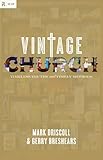 No doubt timing had something to do with it, but Mark Driscoll’s latest book, Vintage Church, is my favorite in his Re:Lit series to date. (If you’re looking at the total Driscoll canon, Confessions of a Reformission Rev is still at the top of my list.) Having written on topics like Jesus, the Atonement, church leadership, and the Bible, the biblical foundations for church was a logical next topic for Driscoll to tackle. And tackle it he does.
No doubt timing had something to do with it, but Mark Driscoll’s latest book, Vintage Church, is my favorite in his Re:Lit series to date. (If you’re looking at the total Driscoll canon, Confessions of a Reformission Rev is still at the top of my list.) Having written on topics like Jesus, the Atonement, church leadership, and the Bible, the biblical foundations for church was a logical next topic for Driscoll to tackle. And tackle it he does.
In Vintage Church, Driscoll’s propensity for landing verbal punches is displayed to good effect. Why? Because the Bible delivers all kinds of body blows to our pride and preferences, and this is never more true than when God speaks about his community, the church. So when we talk about the topic of church, teachers need to let God’s dictates fall. Driscoll does:
The Bible is clear that every Christian is a part of the larger church body and is expected to participate in the life of a local church with the gift(s) God has given him or her. This is so God may be glorified and so his people may be built up through their service to one another. It is therefore a sin for someone who claims to be a Christian not to be actively loving his or her Christian brothers and sisters and seeking to build up the church as fathful members of a church. - Vintage Church, 51
Tough ecclesiology like this leads to a robust explanation of what God’s people are to be and do. Driscoll hits on obvious questions like Who Is Supposed to Lead a Church? Why is Preaching Important? What Are Baptism and Communion? He fleshes his positions out with scriptural care, but also with a practitioner’s eye:
Preaching is like driving a stick: you only get better the more you practice, and the hope is not to kill anyone as you learn, while accepting that a few dents are inevitable. - Vintage Church, 92
Driscoll also discusses topics less-frequently discussed, like church discipline, technology use, and the active role of members. And while I’ve developed a gag reflex for blog posts and titles featuring the word “missional,” “What is a Missional Church?” is one of the best chapters in the book. A few lines…
A missional church goes to great lengths to understand the people God has sent them to. It seeks to know the culture and people better than any other organization, even businesses…(224) Such labor is “for the sake of the gospel,” which means that any church that only does evangelism without first studying the culture in an effort to contextualize does not truly care about the gospel (228).
[Many people] still live under the myth that missions is something that happens across the world rather than across the street, and that missionaries are special people and not normal Christians. This is a sin to be repented of (230).
Too often, what is called a missional church is nothing more than a hip, trendy gathering of the disgruntled children of other churches, where few if any true conversions are experienced (232).
Countercultural living requires becoming a stakeholder in the culture (235).
Gerry Breshears, Driscoll’s co-author, does a very solid job fielding common questions after each chapter, a feature that adds to the book’s blue collar tone. Vintage Church is highly recommended.
Cross-posted on my church plant blog.










2 comments:
I was not a big fan of Vintage Jesus, mostly because I wasn't its intended audience. This book sounds better, but I'm curious as to who you think the intended audience is.
Hey Will, if you didn't like Vintage Jesus that much, this one probably won't thrill you either. I think Driscoll is targeting people who are pretty motivated to learn about theology and church practice...however, if you're interested in the biblical foundations for "church" or the future of the church or the role of leaders in the church, you'll dig this book.
Post a Comment